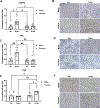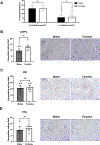Sex differences in neuronal activation during aversion-resistant alcohol consumption
- PMID: 36575056
- PMCID: PMC9992309
- DOI: 10.1111/acer.15006
Sex differences in neuronal activation during aversion-resistant alcohol consumption
Abstract
Background: One of the DSM-5 criteria for Alcohol Use Disorder is continued alcohol consumption despite negative consequences. This has been modeled in mice using adulteration of alcohol solution with the bitter tastant quinine. Mice that continue to consume alcohol despite this adulteration are considered aversion resistant. The limited number of studies dissecting the underlying neuronal mechanisms of aversion-resistant drinking behaviors used only male subjects. We have previously shown that female mice are more resistant to quinine adulteration of alcohol than males. Our aim here is to identify potential sex differences in neuronal activation that may underlie this behavior.
Methods: Male and female C57BL/6J mice were allowed continuous access to 20% alcohol in a two-bottle choice procedure. To test aversion-resistance, the alcohol was adulterated with increasing concentrations (0.03, 0.1, and 0.2 mM) of quinine hydrochloride. After consumption rates were calculated, brains were extracted to examine neuronal activation using Fos immunohistochemistry.
Results: We found that female mice suppressed their intake to a lesser extent than males when the alcohol solution was adulterated with quinine. Our Fos staining revealed three regions of interest that exhibit a sex difference during quinine-adulterated alcohol drinking: the ventromedial prefrontal cortex (vmPFC), the posterior insular cortex (PIC), and the ventral tegmental area (VTA). Both the vmPFC and the PIC exhibited higher neuronal activation in males during quinine-adulterated alcohol consumption. However, females showed higher Fos activation in the VTA during quinine-adulterated alcohol consumption.
Conclusions: Females more readily exhibit aversion-resistant alcohol intake than their male counterparts and exhibit some differences in neuronal activation patterns. We conclude that there are sex differences in neurocircuitry that may underlie compulsive drinking behaviors.
Keywords: EtOH; Fos activation; aversion; consumption; sex differences.
© 2022 The Authors. Alcohol: Clinical & Experimental Research published by Wiley Periodicals LLC on behalf of Research Society on Alcohol.
Conflict of interest statement
Conflict of Interest
The authors declare no conflicts of interest
Figures




References
-
- Centanni SW, Janes AC, Haggerty DL, Atwood B and Hopf FW, 2021. Better living through understanding the insula: Why subregions can make all the difference. Neuropharmacology, 198, p.108765. - PubMed
Publication types
MeSH terms
Substances
Grants and funding
LinkOut - more resources
Full Text Sources

